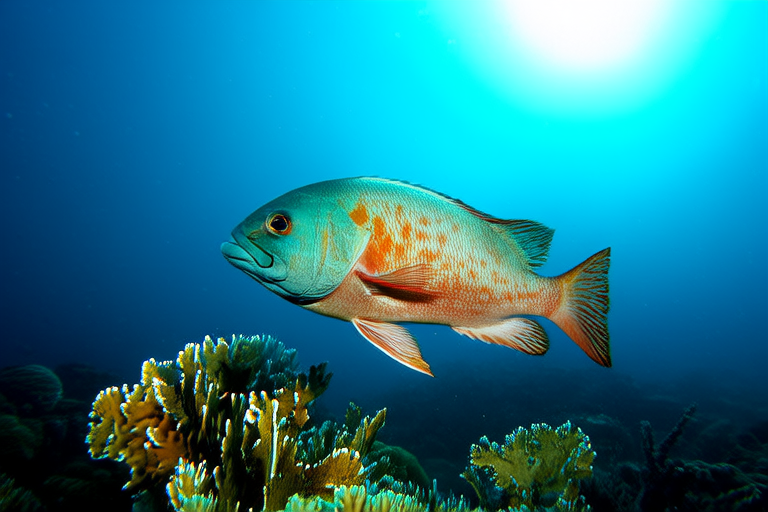Camouflage Techniques of Parrot Fish
The parrot fish is a fascinating marine creature known for its vibrant colors and unique camouflage techniques. These fish employ a variety of strategies to blend into their environment, ensuring their survival against numerous predators. This article delves into the biological mechanisms behind their color-changing abilities, their behavioral adaptations for hiding, and the evolutionary advantages these skills provide.
Biological Mechanisms Behind Color-Changing Abilities
Parrot fish possess chromatophores, specialized cells that contain pigments and can change the coloration of their skin. These cells allow parrot fish to alter their appearance according to their surroundings, making them nearly invisible to predators. The process of changing color involves the expansion or contraction of these cells, controlled by the nervous system. For example, the Scarus psittacus, commonly known as the red parrot fish, can shift its hues from bright red to a more subdued brownish tone when threatened or during resting periods.
Behavioral Adaptations for Hiding
In addition to their color-changing abilities, parrot fish exhibit several behavioral adaptations to avoid detection. They often rest in coral crevices, blending with the intricate patterns of the reef. Some species, like the Scarus vetula (stoplight parrot fish), have evolved to mimic the appearance of coral polyps, further enhancing their camouflage. At night, many parrot fish produce a mucous cocoon around themselves, concealing their scent and making it difficult for predators to detect them.
Evolutionary Advantages of Camouflage
The primary evolutionary advantage of camouflage for parrot fish is increased survival rates. By effectively blending into their environment, they reduce the likelihood of being detected by predators such as sharks, barracudas, and moray eels. This heightened survival rate contributes to higher reproductive success, ensuring the continuation of their species. Moreover, the ability to change color allows parrot fish to communicate within their social groups, signaling readiness to mate or warning others of potential threats.
Comparison with Other Marine Creatures
While many marine animals use camouflage to evade predators, the strategies employed by parrot fish are unique. For instance, cuttlefish can rapidly change their skin texture to match their surroundings, whereas octopuses use ink sacs to create smokescreens. Unlike these cephalopods, parrot fish rely primarily on color changes rather than altering their physical form. Furthermore, while some fish, like the stonefish, adopt a fixed resemblance to rocks or corals, parrot fish can dynamically adjust their appearance based on environmental conditions.
Ecological Importance of Camouflage
The ecological significance of parrot fish camouflage extends beyond individual survival. As herbivores, they play a crucial role in maintaining coral reef health by grazing on algae. Their ability to remain hidden from predators ensures that their population remains stable, allowing them to continue this vital function. However, the increasing threat of climate change poses significant challenges to their camouflage capabilities. Rising ocean temperatures and pollution can disrupt the delicate balance of their ecosystems, potentially diminishing their effectiveness in blending with their surroundings.
Threats to Camouflage Capabilities
Environmental changes, including rising sea temperatures and pollution, pose substantial risks to the camouflage abilities of parrot fish. Elevated water temperatures can stress the fish, affecting their chromatophore function and reducing their capacity to change colors effectively. Pollution, particularly from agricultural runoff and oil spills, can introduce toxins that harm the fish’s nervous systems, impairing their ability to control their color-changing mechanisms. Additionally, habitat destruction, such as coral bleaching events, reduces the complexity of their environments, limiting the number of hiding spots available.
Current Research and Future Studies
Scientists are actively investigating the mechanisms behind the color-changing abilities of parrot fish to better understand their adaptive processes. Recent studies have explored the role of specific genes involved in pigment production and neural pathways responsible for controlling chromatophores. Future research may focus on developing technologies inspired by parrot fish camouflage, with potential applications in military camouflage and anti-counterfeiting measures. Additionally, ongoing efforts aim to mitigate the impacts of environmental changes on marine ecosystems, preserving the habitats essential for parrot fish survival.
In conclusion, the camouflage techniques of parrot fish represent an intricate interplay of biological mechanisms, behavioral adaptations, and evolutionary advantages. Their unique strategies set them apart from other marine creatures and underscore the critical ecological roles they play. As we continue to explore these fascinating organisms, it becomes increasingly important to address the threats facing their habitats and ensure the preservation of their remarkable abilities.
